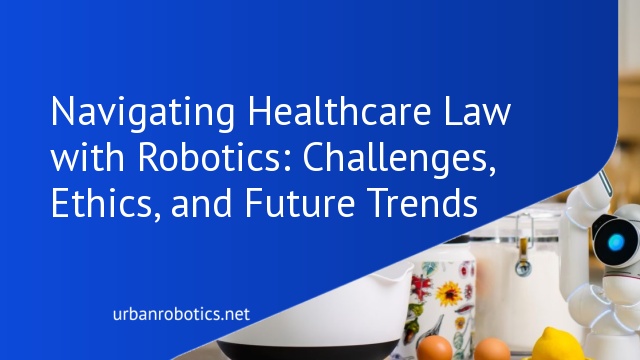Understanding Healthcare Law With Robotics
Healthcare law with robotics involves managing unique legal matters. Liability presents a major challenge, with questions on assigning responsibility in robotic-assisted surgeries. For instance, determining fault between the surgeon and the robot manufacturer proves complex. Assessing these cases requires detailed knowledge of robotics and medical practices.
Data privacy concerns arise due to robotic systems capturing extensive patient data. Ensuring compliance with regulations like HIPAA remains crucial. Failure to protect patient information can result in legal penalties and diminish patient trust.
Regulatory compliance involves adhering to standards set by bodies like the FDA. This ensures that robotic devices meet safety and efficacy criteria. Navigating these regulations can be intricate due to the evolving nature of robotic technology.
Creating a framework for healthcare law with robotics mandates collaboration. Stakeholders, including lawmakers, technologists, and healthcare providers, need to align to support both innovation and patient protection. Through cohesive efforts, the integration of robotics in healthcare can continue advancing while maintaining legal integrity.
The Evolution Of Robotics In Healthcare
Robotics has significantly transformed healthcare, bringing both opportunities and challenges. Examining the evolution helps us understand its current and future impact.
Early Innovations
The first significant use of robotics in healthcare began in the 1980s with robotic-assisted surgeries. One of the earliest instances, the PUMA 560, performed a precise neurosurgical biopsy. Early innovations also included robotic systems like the da Vinci Surgical System, approved by the FDA in 2000, which revolutionized minimally invasive surgeries. These early systems laid the groundwork for current robotic applications in various medical procedures.
Current Advancements
Today, robotics in healthcare encompasses a broad spectrum. Autonomous robots assist in logistics, delivering medications and supplies within hospitals. Surgical robots offer enhanced precision and control, reducing recovery times. For example, the latest da Vinci models enable complex procedures with minimal incisions. Additionally, rehabilitation robots support physical therapy, and AI-powered robots assist in diagnostics and patient care. These advancements reflect the growing integration of robotics in all facets of healthcare.
Legal Considerations And Challenges
Integrating robotics into healthcare brings several legal concerns that require our attention. We need to address patient privacy, liability, and regulatory compliance challenges.
Patient Privacy And Data Security
Patient privacy and data security are critical in healthcare robotics. Robots collect vast amounts of patient data, leading to potential breaches. Ensuring compliance with regulations like HIPAA protects sensitive information. Secure data encryption and access restrictions mitigate unauthorized access risks. For example, the handling of data by diagnostic robots involves stringent privacy measures to prevent unauthorized sharing.
Liability And Accountability
Robotic-assisted surgeries introduce complex liability issues. Determining accountability—whether it be the manufacturer, the software developer, or the medical practitioners—becomes challenging. Clear agreements and thorough documentation are essential. For example, in cases involving surgical robots like the da Vinci system, we must specify responsibilities in the event of malfunctions or errors.
Regulatory Compliance
Regulatory compliance ensures safe and effective use of healthcare robots. The FDA provides guidelines for robotic medical devices, ensuring they meet safety standards. Continuous monitoring and updates to regulations address technological advancements. For instance, compliance involves regular audits and adherence to FDA’s premarket approval processes for new healthcare robots.
Ethical Implications
Integrating robotics into healthcare presents several ethical challenges. These challenges need careful consideration to ensure patient well-being and fairness in technological advancement.
Informed Consent
Patients must understand the implications of robotic-assisted procedures. Informed consent involves clearly explaining risks, benefits, and alternatives. Healthcare providers should ensure that patients are not only aware of the involvement of robots in their care but also comprehend the potential outcomes. Ethical informed consent requires transparency about the capabilities and limitations of the technology used.
Equity In Access To Technology
Ensuring equitable access to robotic healthcare technology is crucial. Disparities may arise due to cost, geographical location, or socioeconomic status. We must implement policies and practices that bridge these gaps. Addressing these disparities ensures that advanced healthcare technologies benefit all patients, not just those with more resources. Equity in access promotes wider acceptance and use of innovative medical solutions.
Future Trends And Predictions
Healthcare law with robotics is set to evolve in several key areas. Regulations will likely become more adaptive, reflecting the rapid pace of technological advancements. Lawmakers may introduce new policies to ensure the safe integration of AI and machine learning in medical devices.
Increased collaboration between tech companies and healthcare providers is expected to drive standards for patient data security. We anticipate that this will address privacy concerns while fostering innovation. For instance, blockchain may be integrated to enhance data management and security.
We also foresee advancements in robotic surgeries, where minimally invasive procedures become the norm. Legal frameworks will need to adapt, addressing issues of liability and professional responsibility. Additionally, autonomous robots might take on more tasks, from diagnostics to treatment, necessitating updates in medical licensing laws.
Ethical considerations will gain prominence, particularly concerning equitable access to robotic technologies. We predict new regulations will focus on ensuring that these advancements benefit all demographics, reducing disparities in healthcare. These trends will redefine how healthcare law interacts with robotics, promoting both safety and innovation.
Conclusion
As we navigate the evolving landscape of healthcare law with robotics, it’s clear that collaboration among stakeholders is crucial. Addressing liability complexities, data privacy concerns, and regulatory compliance will ensure patient safety and innovation. The ethical implications, such as informed consent and equitable access, must remain at the forefront of our efforts.
Looking ahead, adaptive regulations and enhanced patient data security standards will play a significant role in shaping the future. With advancements in robotic surgeries and autonomous robots, we can expect a redefined interaction between healthcare law and robotics. Let’s continue to prioritize both technological progress and patient well-being in this dynamic field.





